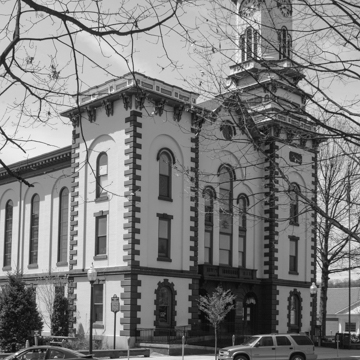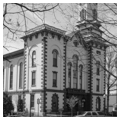The Northumberland County Courthouse is a landmark in the rising professional status of the architect. The county commissioned Rissel, the builder of the Samuel Sloan–designed Lycoming County Courthouse (1860–1861; 1969 demolished), to construct a new courthouse using Sloan's plans without his permission. Rissel shifted the clock tower from the left to the right side of the facade, but otherwise the designs were virtually identical. Although building plans were not yet protected by the Copyright Act of 1909, Sloan sued for his fees and won, establishing the principle that architects retain ownership of their drawings which are instruments of service. Sloan's design was based on the twolevel urban church with offices below and a monumental courtroom in place of the sanctuary above. He overlaid the fashionable vertical proportions and round-arched details of the Norman Revival on a volume that could equally have served a church or a courthouse. The original rich Victorian hues of the red brick walls trimmed with Hummelstown brownstone quoins would have been very different from the present white and green painted facade that reverts to the light hues of the earlier Greek Revival. The second-story courtroom was the site of the final trials of the Molly Maguires in 1878, ending with a conviction and hanging at the county prison on 2nd and Arch streets (designed on the John Haviland model by Danville architect Charles S. Wetzel in 1876). Much of the courthouse's interior was remodeled in 1915 when the rear wing was added.
You are here
Northumberland County Courthouse
If SAH Archipedia has been useful to you, please consider supporting it.
SAH Archipedia tells the story of the United States through its buildings, landscapes, and cities. This freely available resource empowers the public with authoritative knowledge that deepens their understanding and appreciation of the built environment. But the Society of Architectural Historians, which created SAH Archipedia with University of Virginia Press, needs your support to maintain the high-caliber research, writing, photography, cartography, editing, design, and programming that make SAH Archipedia a trusted online resource available to all who value the history of place, heritage tourism, and learning.




















